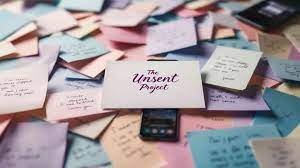The Unsent Project is a captivating social art initiative that explores the emotional impact of unsent love letters. Created by artist Rora Blue, the project gives people a chance to anonymously submit messages they never got to send to their first loves. Whether filled with heartbreak, longing, gratitude, or regret, each message is a raw, unfiltered glimpse into the human experience. The Unsent Project has grown into a global phenomenon, creating a digital space where vulnerability, memory, and emotion collide.
The Origins of the Unsent Project
The began in 2015 as a personal art experiment. Rora Blue was curious about how people express love and what they might say if given one more chance. What started as a small collection of messages has evolved into a massive archive containing hundreds of thousands of submissions from people all over the world.
Each message is also tied to a color, asking users to choose the color they associate with their first love. This adds a visual and emotional layer to the project, revealing how deeply color and emotion are linked.
Why the Unsent Project Resonates with So Many
The resonates with a global audience because it taps into something universal — unspoken words and unresolved emotions. Most people have experienced the pain of things left unsaid. This project creates a safe, anonymous space to say those things, even if they never reach the intended recipient.
It’s also a form of emotional release. Writing an unsent letter can be therapeutic, helping individuals move on, gain clarity, or feel heard. By sharing these letters, contributors become part of a collective story that’s relatable, honest, and often heartbreaking.
Unsent Project: The Role of Color in Emotional Expression
One of the unique aspects of the is the use of color. When users submit their unsent letters, they are asked to assign a color that represents their message or their former lover. This turns the emotional experience into a visual one, allowing viewers to “feel” the mood of each message through color.
For example:
-
Red often represents passion, anger, or heartbreak.
-
Blue might signify sadness, calm, or nostalgia.
-
Pink often relates to tenderness or innocence.
-
Black can embody grief, loss, or betrayal.
These color choices create a rainbow of emotions across the project, offering insights into how color reflects our inner worlds.
The Impact of the Unsent Project on Social Media
The found viral popularity through platforms like Instagram, TikTok, and Tumblr. Many users repost their favorite messages or create aesthetic content inspired by the submissions. This social media engagement has helped the project reach new audiences, especially among Gen Z and Millennials.
Some messages have gained viral fame for their intensity or relatability. Others have sparked conversations about relationships, forgiveness, and healing. The project has even inspired art exhibits, merchandise, and mental health discussions.
Unsent Project as a Form of Digital Therapy
In many ways, the acts as a form of digital therapy. It encourages self-reflection and provides emotional catharsis. Users report feeling lighter after submitting their messages — as if they’ve let go of emotional baggage.
The anonymity allows for complete honesty, without fear of judgment or confrontation. For those who struggle to communicate emotions in real life, this platform becomes a powerful outlet for emotional processing.
Criticism and Praise of the Unsent Project
Like any large-scale art project, the has faced both praise and critique.
Critics argue that the platform may sometimes romanticize unhealthy relationships or keep people stuck in the past. There are also concerns about emotional voyeurism, as viewers read deeply personal content without context.
Supporters, however, emphasize the project’s value in emotional expression and connection. They argue that the Unsent Project helps people understand they’re not alone in their experiences. The honesty of the messages fosters empathy, compassion, and a sense of shared humanity.
The Educational and Artistic Value of the Unsent Project
Educators and artists have also found value in the. Teachers use it in creative writing or psychology classes to discuss emotion, narrative voice, and catharsis. Artists have created collages, poetry, and installations inspired by the messages.
The project is a treasure trove of raw human expression — a living, breathing archive of love and loss. Its structure invites reflection not only on individual relationships but also on how society views love, closure, and vulnerability.
How to Participate in the Unsent Project
Participating in the Unsent Project is simple:
-
Visit the official website.
-
Write your unsent message anonymously.
-
Choose the color that represents your former love.
-
Submit.
Your message becomes part of the global archive, and you can also explore submissions from others based on color, emotion, or keyword. Reading these messages can be as transformative as writing your own.
Conclusion: Why the Unsent Project Matters
The is more than an art piece — it’s a mirror reflecting the deepest corners of the human heart. It reminds us of the complexity of love, the weight of unspoken words, and the beauty of emotional honesty. In a world where oversharing is often superficial, this project encourages meaningful self-expression and silent connection.
Whether you’re writing to heal, reading to understand, or scrolling for comfort, the a space where your feelings are valid, even if the words are never sent.





